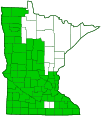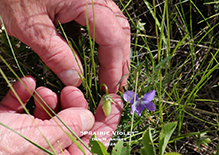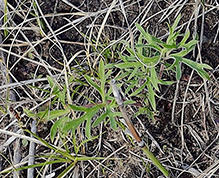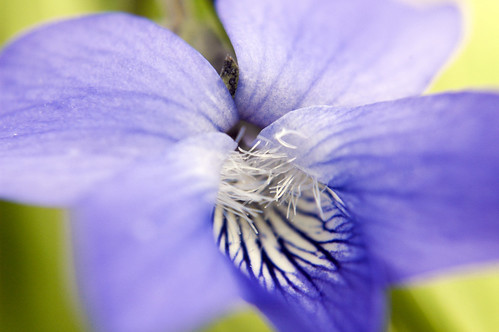prairie violet
(Viola pedatifida)
Conservation • Wetland • Description • Habitat • Ecology • Use • Distribution • Taxonomy
Description |
Prairie violet is a 3″ to 6″ tall, erect, perennial forb that rises from a short, slanted or erect caudex and fibrous roots. There is no central stem. The leaves are all basal and form a rosette. They are on stalks up to 1″ long. The leaf blades are 1″ to 3″ long and 1″ to 4″ wide. They are dissected almost to the base into usually 3 main divisions. Each division is again deeply cut into 2 to 4 linear segments, and the segments are often again lobed. Early leaves and later leaves are equally divided. The upper and lower surfaces may be moderately covered with spreading hairs or almost hairless. The margins are untoothed and have a fringe of hairs. One to several leafless flower stalks (scapes) rise from the rootstock at the middle of the rosette. The scape is erect, leafless, and hairless, and is topped with a single flower. It is abruptly curved downward near the top. The flowers are usually held above the early leaves but are often overtopped by later leaves. Two types of flowers are produced: open, cross-pollinated (chasmogamous) flowers; and closed, self-fertilizing (cleistogamous) flowers. Cross-pollinated flowers are ¾″ to 1 3 ⁄16″ wide and showy. There are 5 sepals, 5 petals, 5 stamens, and 1 style. The sepals are green and shorter than the petals. The petals are violet or pale violet and ¼″ to ¾″ long. The two upper petals are erect or bent backward. The three lower lobes are spreading, white at the base, and have a tuft of white hairs (beard) near the throat. The lowest lobe has conspicuous, dark purple veins near the throat and a hooked, rounded spur at the base. The 5 stamens are orange and have very short filaments. They do not protrude from the throat of the corolla and are concealed by the beards of the petals. The flowers are not fragrant. Self-pollinating flowers occur on shorter scapes that may be erect or lie flat on the ground. The fruit is an egg-shaped to ellipse-shaped, ¼″ to ⅓″ long, hairless, yellowish-brown capsule with many brown seeds. The capsule protrudes noticeably beyond the persistent sepals. |
Height |
3″ to 6″ |
Flower Color |
Violet to pale violet |
Similar Species |
Birdfoot violet (Viola pedata) flowers are somewhat larger, up to 1½″ wide. The lower 3 petals are not bearded. The stamens protrude conspicuously from the throat of the corolla. It does not produce cleistogamous flowers. It is found in southeast and east-central Minnesota. |
Habitat |
Dry to moderate moisture. Prairies, forest and woodland openings. Full sun. |
Ecology |
Flowering |
April to June |
Pests and Diseases |
|
Use |
|
Distribution |
||
|
Sources |
|
| 5/7/2024 | ||
Nativity |
||
Native |
||
Occurrence |
||
Common |
||
Taxonomy |
|
Kingdom |
|
Division |
Tracheophyta (Vascular Plants) |
Subdivision |
Spermatophytina (Seed Plants) |
Class |
|
Order |
Malpighiales (Nances, Willows, and Allies) |
Family |
Violaceae (violet) |
Subfamily |
Violoideae |
Tribe |
Violeae |
Genus |
Viola (violets) |
Subgenus |
Viola (pansies and violets) |
Section |
Nosphinium |
Subsection |
Borealiamericanae (eastern American blue violets) |
Subordinate Taxa |
|
|
|
Synonyms |
|
Viola delphinifolia Viola palmata var. pedatifida Viola pedatifida ssp. pedatifida Viola pedatifida var. pedatifida |
|
Common Names |
|
bearded birdfoot violet crowfoot violet larkspur violet prairie birdfoot violet prairie violet |
|
Glossary
Bearded
Bearing one or more tufts of hairs.
Caudex
A short, thickened, woody, persistent enlargement of the stem, at or below ground level, used for water storage.
Cleistogamous
Automatically self-pollinating. Refers to bud-like flowers that do not open but automatically self-pollinate, or to plants with such flowers.
Corolla
A collective name for all of the petals of a flower.
Linear
Long, straight, and narrow, with more or less parallel sides, like a blade of grass.
Scape
An erect, leafless stalk growing from the rootstock and supporting a flower or a flower cluster.
Visitor Photos |
||
Share your photo of this plant. |
||
This button not working for you? |
||
Dan W. Andree |
||
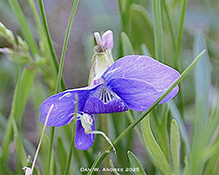 |
||
Northern Crab Spider on a Prairie Violet... It looks more like an illustration than a photo. It's that little crab spider that was hiding behind the blossom and when I touched the blossom it thought I was an insect or something for lunch until it realized it was a bit tooo big. It then scooted back behind the prairie violet blossom. Eventually came out. Funny little spider. |
||
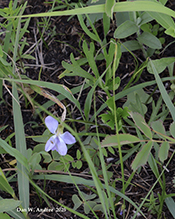 |
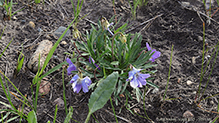 |
|
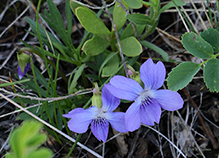 |
||
Prairie Violet... I’m not into flowers all that much, but I was out there and they were there and looked nice so thought I’d share some. |
Prairie Violet and Seed Pod... Looks like they are starting to get seed pods or whatever they call them. Most of the prairie violets I seen were withering or done blooming. Only a few still blooming but a lot less than a week or two ago. |
|
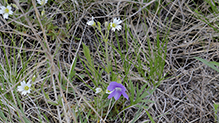 |
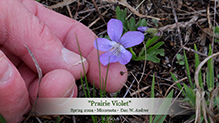 |
|
Field Chickweed and a Prairie Violet... This is another Field Chickweed I seen and a Prairie Violet. |
A real Little Prairie Violet Plant... A light rain shower left small remaining raindrops on this little prairie violet. Seems like there are many images/pictures/videos etc. of large groups of blooming flowers captured which I can understand, but this little native prairie plant was too cute to pass up. They sure don’t have to get very big to bloom though I am sure it will continue to grow some. Seems like it was just getting a start. I may use it in a video since this is a still image from the video I took of it. Some little things though can go unnoticed are beautiful too. |
|
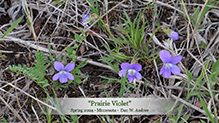 |
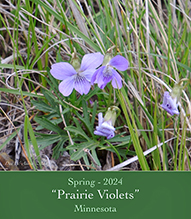
|
|
Prairie Violets... These were from yesterday May 16, 2024 at a Prairie area in Norman Co. Mn. I filmed them too and will possibly use some footage in an upcoming video since they are a small but crucial plant for certain species of butterflies like the regal fritillary. Also they seen to be photogenic little plants. One should note wood ticks are out in full force in certain areas. There was some recent rains and a cooler morning and early afternoon and seems like wood ticks are a lot less out right after recent rains and a cooler night. But today it is suppose to be around 80 to low 80’s and its been sunny so I am sure the little creeps are back out in full force in some areas. One just needs to be aware especially in spring seems like they are the most abundant then, but best to be aware all season. |
||
Prairie Violets... I came across these while out on a prairie in Norman County, Mn. on 5-14-24. First time I had ever seen one other than in photos or some online videos. Not easy to find they are so small and low to the ground other vegetation can conceal them. I found them to be an interesting and a beautiful little plant. I plan on checking again to see if more become visible since some seemed to almost just be sprouting or starting out. I really appreciate the little violets. |
||
|
||
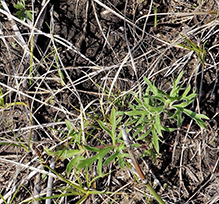 |
||
Some small Prairie Plant... They kind a look like some online prairie violet plants but these didn’t have any flowers on them at least not yet. They were real small even though look larger in the photos. They were on a Prairie in Norman Co. today... 5-7-24 |
||
MinnesotaSeasons.com Photos |
||
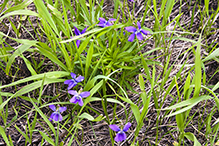 |
 |
|
Plant |
Plant | |
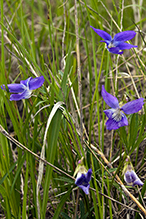 |
 |
|
Plant |
Plant | |
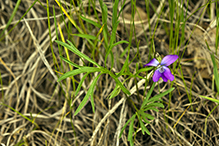 |
 |
|
Plant |
Plant | |
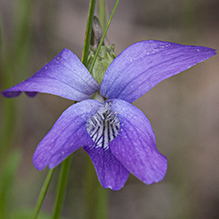 |
||
Flower |
||
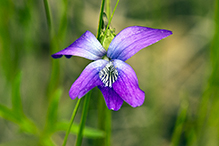 |
 |
|
Flower |
Flower | |
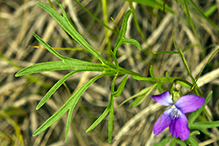 |
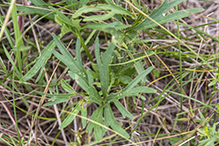 |
|
Leaves |
Leaves | |
 |
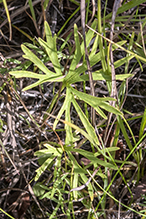 |
|
Leaves |
Leaves | |
 |
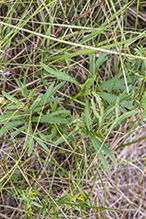 |
|
Leaves |
Leaves |

Visitor Videos |
||
Share your video of this plant. |
||
This button not working for you? |
||
|
Other Videos |
||
|

Visitor Sightings |
||
Report a sighting of this plant. |
||
This button not working for you? |
||
Dan W. Andree |
Location: Twin Valley Prairie SNA |
 |
Dan W. Andree |
Location: Norman Co. Mn. It looks more like an illustration than a photo. It's that little crab spider that was hiding behind the blossom and when I touched the blossom it thought I was an insect or something for lunch until it realized it was a bit tooo big. It then scooted back behind the prairie violet blossom. Eventually came out. Funny little spider. |
 |
Dan W. Andree |
Location: SNA in Norman Co. Mn. |
 |
Dan W. Andree |
Location: SNA in Norman Co. Mn. Looks like they are starting to get seed pods or whatever they call them. Most of the prairie violets I seen were withering or done blooming. Only a few still blooming but a lot less than a week or two ago. |
 |
Dan W. Andree |
Location: A prairie in Norman Co. Mn. This is another Field Chickweed I seen and a Prairie Violet. |
 |
Dan W. Andree |
Location: Norman Co. Mn. These were from yesterday May 16, 2024 at a Prairie area in Norman Co. Mn. I filmed them too and will possibly use some footage in an upcoming video since they are a small but crucial plant for certain species of butterflies like the regal fritillary. Also they seen to be photogenic little plants. One should note wood ticks are out in full force in certain areas. There was some recent rains and a cooler morning and early afternoon and seems like wood ticks are a lot less out right after recent rains and a cooler night. But today it is suppose to be around 80 to low 80’s and its been sunny so I am sure the little creeps are back out in full force in some areas. One just needs to be aware especially in spring seems like they are the most abundant then, but best to be aware all season. |
 |
Dan W. Andree |
Location: Norman Co. Mn. I came across these while out on a prairie in Norman County, Mn. on 5-14-24. First time I had ever seen one other than in photos or some online videos. Not easy to find they are so small and low to the ground other vegetation can conceal them. I found them to be an interesting and a beautiful little plant. I plan on checking again to see if more become visible since some seemed to almost just be sprouting or starting out. I really appreciate the little violets. |
 |
Dan W. Andree |
Location: a Prairie in Norman Co. They kind a look like some online prairie violet plants but these didn’t have any flowers on them at least not yet. They were real small even though look larger in the photos. They were on a Prairie in Norman Co. today... 5-7-24 |
 |
MinnesotaSeasons.com Sightings |
||

|
Created: 8/9/2013 Last Updated: © MinnesotaSeasons.com. All rights reserved. |
